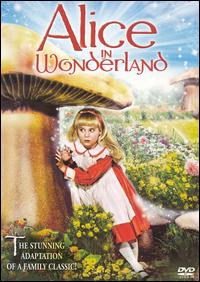Part 1 – Alice in Wonderland
After helping her mother set the table for tea time, Alice goes outside to see her sister and play with her kitten, Dinah. The White Rabbit comes running by, saying he's late. Wondering where he is going, Alice follows him and tumbles into his hole.
Alice finds herself in a hall with many doors, all of them locked. On a table is a key which she can use to open one small door. A small bottle appears labeled "Drink Me." By drinking from the bottle, she shrinks to the right size for the door, but can no longer reach the key to open it. She then eats a little cake, which makes her grow to over nine feet tall. Frustrated, Alice begins to cry. The White Rabbit appears, but frightened of the giant Alice, runs away, dropping his fan and gloves. Using the fan makes Alice shrink again, which takes her diving in her pool of tears, where she meets The Lory Bird, The Dodo Bird and the Mouse, who tells her why he hates dogs and cats ("I Hate Dogs and Cats").
The White Rabbit mistakes Alice for his housemaid Mary Ann and orders her to go get his fan and gloves from his house. While searching his house, Alice finds another "Drink Me" bottle, which makes her grow to nine feet tall once again. Angry at Alice, the rabbit and his butler Pat the Guinea Pig begin throwing berries at her, which turn into little cakes. She eats one and shrinks to back to size. After running away, she meets the Caterpillar who tells her the story "You are Old, Father William". She then meets The Duchess and her cook; the Cheshire Cat, who tells her "There's No Way Home"; and the Mad Hatter, March Hare, and Dormouse having an outdoor tea party ("Laugh"). Alice runs off back on her quest for the White Rabbit, and meets a baby fawn in the forest, the only normal thing she's seen so far ("Why Do People Act as If They're Crazy?").
Alice stumbles upon a doorway that leads to the rose garden of the Queen of Hearts, who always yells "Off with her Head!" She leaves to visit the Gryphon and Mock Turtle ("Nonsense"), but then she is called to attend the trial of the Knave of Hearts, who is accused of having stolen The Queen's tarts. Alice stands up to the Queen and is forced to flee the court. She trips and falls and finds herself back home.
Alice runs inside, only to discover herself trapped on the other side of the mirror. She notices a large book next to her and starts reading a poem called Jabberwocky about a scary monster, a dragon called the Jabberwock. The lights go out, and the Jabberwock appears in the house.
Part 2 – Through the Looking-Glass
The Jabberwock disappears as Alice hides behind the chessboard, knocking it over. As she places the pieces back on the table, she realizes they are all alive, but can't hear her. Desperate for a clue, Alice looks around the room and sees a painting of an Owl, which comes to life and explains that the Jabberwock is a creation of Alice's own childish fears, which she must overcome in order with the courage to return to the real world.
Alice has an interesting conversation with some talking flowers and meets The Red Queen from the chess set, now human-sized. The Red Queen tells Alice that she is now a pawn in a giant game of chess. Once Alice reaches the eighth square to become a queen, she can go home. She boards a train to the fourth square, where she meets the gnat and then Tweedledum and Tweedledee, who teach her the proper way to "Shake Hands" and sing the story of "The Walrus and the Carpenter". She meets The White Queen ("Jam Tomorrow, Jam Yesterday") and Humpty Dumpty. The Jabberwock appears again and knocks Humpty Dumpty off of his wall.
Alice meets The White King and his messenger, who bring Alice to see "The Lion and the Unicorn" as they fight for the crown. The Lion and the Unicorn call a temporary truce and Alice hands out a tray of Looking-Glass Cake, which must be passed around first, then cut after. She is captured by the Red Knight and rescued by the White Knight, who sings and dances her all the way to the eighth square ("We are Dancing"). She meets up with the Red Queen and White Queen, who have a few "Queenly" tests ("Can You do Addition") and some words of wisdom for her ("Emotions"). The White Queen falls asleep on Alice's lap and the Red Queen sings her a lullaby ("Hush-a-bye Lady"). Alice finds her way to her castle, where a great feast has been set in her honor ("To the Looking-Glass World").
A present is brought to her, out of which comes The Jabberwock. The Owl tells her to act brave. Alice finds her way back to the mirror and into her home, where she confronts The Jabberwock, telling him that he is just in her imagination and that she does not believe in him. In a billow of red smoke and lightning, the Jabberwock disappears this time for good. Alice slumps into a chair and is woken up by her Mother calling Alice to tea. When Alice heads upstairs to change for tea, she sees her Wonderland family in the mirror, and they bid farewell to her ("Alice").
